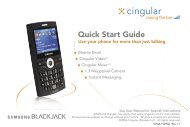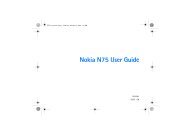You also want an ePaper? Increase the reach of your titles
YUMPU automatically turns print PDFs into web optimized ePapers that Google loves.
98<br />
Safety Guidelines<br />
on possible effects of wireless phone use<br />
on human health.<br />
The FDA belongs to an interagency working<br />
group of the federal agencies that have<br />
responsibility for different aspects of RF<br />
safety to ensure coordinated efforts at the<br />
federal level. The following agencies belong<br />
to this working group:<br />
] National Institute for Occupational Safety<br />
and Health<br />
] Environmental Protection Agency<br />
] Occupational Safety and Health<br />
Administration<br />
] National Telecommunications and<br />
Information Administration<br />
] The National Institutes of Health<br />
participates in some interagency working<br />
group activities, as well.<br />
The FDA shares regulatory responsibilities<br />
for wireless phones with the Federal<br />
Communications Commission (FCC). All<br />
phones that are sold in the United States<br />
must comply with FCC safety guidelines that<br />
limit RF exposure. The FCC relies on the FDA<br />
and other health agencies for safety<br />
questions about wireless phones.<br />
The FCC also regulates the base stations<br />
that the wireless phone networks rely upon.<br />
While these base stations operate at higher<br />
power than do the wireless phones<br />
themselves, the RF exposures that people<br />
get from these base stations are typically<br />
thousands of times lower than those they<br />
can get from wireless phones. Base stations<br />
are thus not the subject of the safety<br />
questions discussed in this document.<br />
3. What kinds of phones are the subject of<br />
this update?<br />
The term ‘wireless phone’ refers here to<br />
handheld wireless phones with built-in<br />
antennas, often called ‘cell’, ‘mobile’, or<br />
‘PCS’ phones. These types of wireless<br />
phones can expose the user to measurable<br />
radio frequency(RF) energy because of the<br />
short distance between the phone and the<br />
user’s head. These RF exposures are limited<br />
by FCC safety guidelines that were<br />
developed with the advice of the FDA and<br />
other federal health and safety agencies.<br />
When the phone is located at greater<br />
distances from the user, the exposure to RF<br />
is drastically lower because a person’s RF<br />
exposure decreases rapidly with increasing<br />
distance from the source. The so-called




